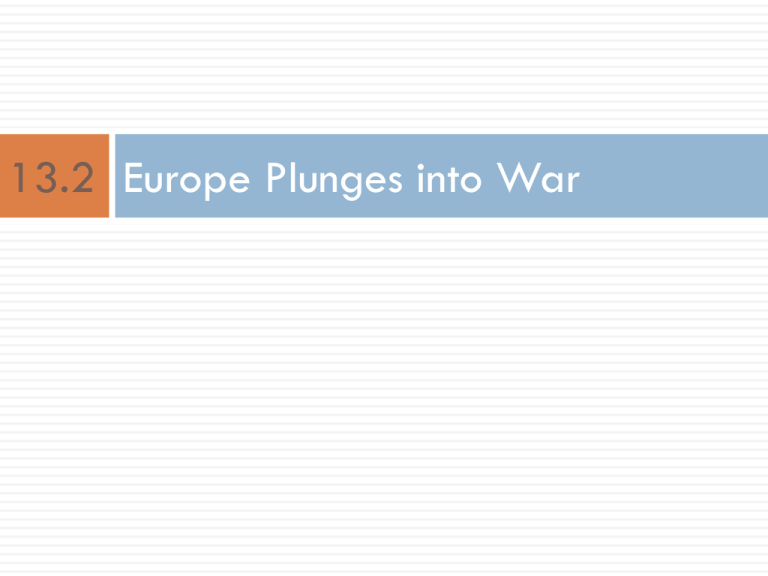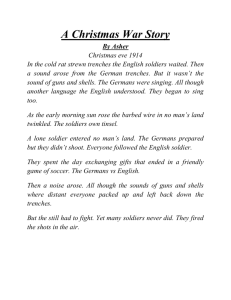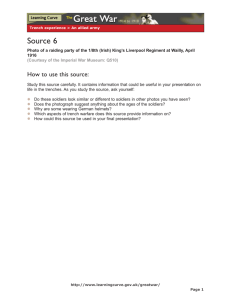13.2 Europe Plunges into War
advertisement

13.2 Europe Plunges into War The Schlieffen Plan •General Alfred Graf von Schlieffen of Germany •1905: Devised a strategy that would be able to counter a joint attack (war on two fronts) 1. Quickly get through the Belgian lowlands to Paris and capture France •Believed it would take Russia 6 weeks to organize its army to attack Germany •Important to force France to surrender before Russia was ready 2. German armies would help defeat the Russians 3. After the defeat, France, & Russia would be unwilling to keep fighting The Schlieffen Plan •Aug. 2nd, 1914: Schlieffen Plan put into operation •German Army invaded Luxembourg & Belgium •Germans held up by the Belgian Army •Surprised by how quickly the British reached France and Belgium •Shocked by the Russian army's advance into East Prussia German troops swept through Belgium & thousands of Belgium refugees fled in terror. U.S. war correspondent Richard Harding Davis described the scene in Belgium: “We found the streets blocked with their carts. Into these they had thrown mattresses, or bundles of grain, & heaped upon them were families of three generations. . . Heart broken, weary, hungry, they passed in an unending caravan.” Western Front • • Deadlocked region in northern France • German forces were unable to break through Allied lines 1st Battle of the Marne • 1st major clash • Sept 9th: General Helmuth von Moltke (German Commander) ordered retreat • British & French forces were able to cross the Marne • Most important event of the war • Defeat of Germans and left Schlieffen Plan in ruins Western Front • • Germany had to fight a war on 2 fronts • Germany sent thousands of troops from France to aid forces in the east • War in the west became a stalemate Early 1915: Trench warfare • Dug miles of trenches to protect themselves from enemy fire • Germans were 1st to decide where to dig & chose the higher ground • Gave the Germans a tactical advantage, but it http://www.history.com/topic • Forced the British & French to live in the worst conditions s/world-wari/videos#trench-warfare • Usually found water 2-3 ft below surface • Never-ending struggle against water and MUD • Duck-boards were placed at the bottom to protect soldiers feet Trench Design • • • About seven feet deep and six feet wide Front of the trench was known as the parapet • Top 2-3 ft of the parapet and the parados (the rear side of the trench) would consist of a thick line of sandbags to absorb any bullets or shell fragments In a trench of this depth it was impossible to see over the top, so a two or three-foot ledge known as a fire-step, was added. Trench Extensions • • Saps (short trenches) were dug from the front-trench into No-Man's Land • Sap-head used as listening posts Front-line trenches were not dug in straight lines • French - zigzags • British – alternated fire-bays (straight sections) and traverses (angles) • Limited the effect of shell-burst Trenches extensions (cont.) • • • • Protected by thick barbed-wire entanglements Usually placed to prevent enemy from getting close enough to lob in grenades Some set up to channel attacking infantry into machine-gun fire Virtually impassable • Offensive soldiers sent out with wire-cutters • Heavy bombardment No Man's Land • • • • Ground between two opposing trenches • Average distance about 250 yards • Narrowest gap about 7 yards Contained a considerable amount of barbed wire If the area had seen a lot of action… • Full of broken & abandoned equipment, contain a large # of bodies Men sometimes ordered into No Man's Land to get info about the enemy • Night patrols • Crawl on their stomachs Lice Soldiers faced mental and physical • • • • • problems while fighting in the trenches. About the size of a sesame seed Have six legs with claws One night, as we lay in bed after doing Left blotchy red bite marks all our two hours' sentry - we did two over the body hours on and two hours off - my friend Jock said ‘I cannot stand it any longer!' Created a sour; stale smell He took off his tunic - we slept in these Carried disease - then he took off his jersey, then his • • • • Pyrexia or trench fever Symptoms: shooting pains in the shins & a high fever Stop soldiers from fighting Accounted for about 15% of sickness in British Army shirt. He put his shirt in the middle of the dug-out floor and put his jersey and tunic on again. As we sat up in bed watching the shirt he had taken off and put it on the floor it actually lifted; it was swarming with lice. ~Henry Gregory of 119th Machine Gun company Trench Foot • • • • • • Infection of the feet Caused by cold, wet, & unsanitary conditions Men stood for hours in waterlogged trenches • Feet would go numb • Skin would turn red or blue Could turn gangrenous and result in amputation Winter of 1914-15: over 20,000 men in British army treated Remedy was to dry their feet & change their socks several times a day • If you have never had trench feet described to you. I will tell you. Your feet swell to two or three times their normal size and go completely dead. You could stick a bayonet into them and not feel a thing. • If you are fortunate enough not to lose your feet and the swelling begins to go down. It is then that the intolerable, indescribable agony begins. I have heard men cry and even scream with the pain and many had to have their feet and • legs amputated. - Sergeant Harry Roberts, interviewed after the war. *End of 1915: British soldiers ordered to change socks at least twice a day *Covered their feet with a grease made from whale-oil *A battalion at the front would use 10 gallons a day Rats • • • • • • • • Attracted by the smell and damp conditions Would eat men's uniforms Sometimes would bite soldiers • Would cause pain & often lead to infection In extreme cases, a wounded or unprotected soldier could be eaten alive by a large group of rats Dead corpses would often be eaten by the rats One soldier described the rats as “small dogs” that would attack and eat anything. Wounded men were often afraid to go to sleep in their beds Men tried to secure food during the night to stop rats from getting it Dysentery • • • Inflammation of the lining of the large intestines • Strips the lining from the stomach • Causes stomach pains, diarrhea, vomiting, and fever Can be fatal if the body dehydrates Bacteria enter the body through • Food or water • Human feces and contact with infected people Shell shock • • Result of stress and trauma Soldiers would become unstable • Extreme panic • Would not be able to concentrate • Losing control mentally WWI ALSO BROUGHT ABOUT NEW WEAPONS OF WAR AS WELL AS A NEW KIND OF WARFARE: FLAME THROWERS, POISONOUS GAS, MACHINE GUNS, TANKS AND AIR PLANES http://www.history.com/topics/world-war-i/videos#wwi-firsts Flame Throwers • • • • • Oct. 1914: Flame-throwers were first used at the Western Front Used pressurized air, carbon dioxide or nitrogen to force oil through a nozzle • Ignited by a small charge, the oil became a jet of flame Operated by two men Used to clear enemy soldiers from front-line trenches Problems: • Range of 25 to 40 meters • Only effective over narrow areas of No Man's Land • Difficult to move around • Only contained enough oil to burn 40 seconds at the time • Soldiers who operated them had a short-life span • Target of rifle and machine-gun fire Grenade •Detonate two different ways: impact or timed-fuse Chlorine Gas • • • Deadly substance • Destroyed respiratory organs, slow death German army first used it against the French • Yellow-green clouds • Thought the German were hiding behind a smokescreen, ready to attack until they felt a burning in their chests and throats • An hour later was a 4-mile gap in the French line Allied forces began wearing gas masks • Handkerchiefs dampened with a solution of bicarbonate of soda • More efficient masks made later Machine Guns • • • • Fires ammunition automatically Much improved by the time of World War I Could wipe out waves of attackers & make it difficult for forces to advance Helped create a stalemate Tanks • • • • Armored combat vehicle Moved on chain tracks Introduced by the British in 1916 at the Battle of the Somme Early tanks were slow & clumsy & could not cross many trenches http://military.discovery.com/vid eos/world-war-1-videos/ Click on WW1 Tanks Airplane • Submarine • 1st time in history planes used in a combat http://www.history.com /videos/interrupter1. Used for taking photos air-combatrevolution#interrupterof enemy lines air-combat-revolution 2. Used to drop bombs • 3. Guns were attached & pilots fought each other in the air. 1914: Germans introduce the submarine as warship • Aka U-boats • Eventually waged unrestricted warfare on Allied ships Primary weapon: torpedo • Self-propelled underwater missile Battle of Verdun: Germany vs. France Date: Feb. 1916 – Dec. 1916 Location: Verdun, France Result: Stalemate War of Attrition Over 700,000 casualties! Wearing the other side down is the only military strategy! Battle of the Somme July 1st, 1916 –Britain and France attacked the German line in France. Four months later: The British gained 5 miles. One million soldiers were dead or wounded. Battle on the Eastern Front The Eastern Front was a stretch of battlefield along the German & Russian border. Here, Russians & Serbs battled Germans, Austrians & Turks Eastern Front • • Beginning of the war: Russia launched an attack into both Austria & Germany August 1914: Germany counterattacked near Tannenberg • • • • • • 4 day battle Germans crushed the invading Russian army & drove it into full retreat Germany regained East Prussia & seized guns & horses More than 30,000 Russian soldiers were killed Sept. 1914: Russian forces defeated the Austrians twice • Drove them deep into Austria Dec. 1914: Austria & Germany defeat the Russians • Drove them eastward out of Austria-Hungary Eastern Front • • By 1916 (2 years later) Russia’s war effort near collapse Russia not yet industrialized like the western European nations • Constantly short on food, guns, ammo, clothes, boots, & blankets Allies unable to ship supplies to Russia’s ports • German naval fleet blocked the Baltic Sea • Ottomans controlled straits from the Mediterranean to the Black Sea Eastern Front • • • Russia One asset: population Suffered huge battlefield losses • 1915: More than 2 million Russian soldiers killed, wounded, or captured • Army continually rebuilt its ranks from the population Managed to tie up hundreds of thousands of German troops on Eastern Front • Prevented the Germans from launching its full fighting force in the west




